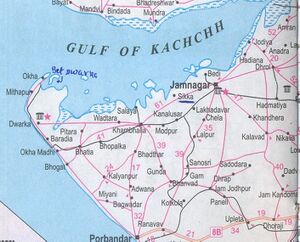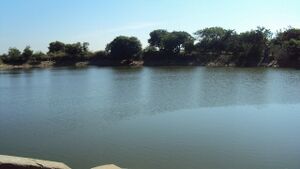Bet Dwarka
| Author:Laxman Burdak, IFS (R) |

Bet Dwarka (बेट द्वारका) is an island that lies on the other side of a small creek from Okha port in Gujarat.
Okha is a small coastal town in Jamnagar district of Gujarat state in India. It has a sea port. Okha is famous for its Krishna Temple Bet Dwarka dedicated to Krishna on Bet Dwarka island across a small creek from Okha port.
Variants
- Betadvaraka बेटद्वारका, कठियावाड़, गुजरात, (AS, p.642)
- Antardvipa (अन्तर्द्वीप)
- Kusasthali (कुशस्थली)
- Shankhoddhara (शंखोद्धार)
History
The island of Bet Dwarka is identified with Antardvipa and Kusasthali as mentioned in the Mahabharata.[1]
The island of Bet Dwarka also known as Shankhoddhara situated 30 km north of Dvaraka was explored, as Krishna is said to have brought the Yadavas first to Kusasthali in Bet Dwarka and rebuilt the town Dvaraka.[2] Sankhar (संखार) or Sankhal (संखाल) is is clan[3] supposed to be descendants of Nagavanshi King Shankha (शंख) of Mahabharata period. [4]
Archaeological findings
On May 19, 2001, India's science and technology minister Murli Manohar Joshi announced the finding of ruins in the Gulf of Khambhat. The ruins, known as the Gulf of Khambhat Cultural Complex (GKCC), are located on the seabed of a nine-kilometer stretch off the coast of Gujarat province at a depth of about 40 m. The site was discovered by a team from the National Institute of Ocean Technology (NIOT) in December 2000 and investigated for six months with acoustic techniques.
A follow up investigation was conducted by the same institute in November 2001, which included dredging to recover artifacts. A round of further underwater explorations was made in the Gulf of Khambhat site by the NIOT team from 2003 to 2004, and the samples obtained of what was presumed to be pottery were sent to laboratories in Oxford, UK and Hannover, Germany, as well as several institutions within India, to be dated. In a 2003 paper A.S. Gaur and Sundaresh of National Institute of Oceanography concluded "The present excavation has thrown a light on the cultural sequence of Bet Dwarka Island. Around the 17th century B.C. Late Harappan people had established their settlement and they perhaps migrated from Nageshwar which is close by. They have exploited marine resources such as fish and conch shells. It appears that Late Harappans of Bet Dwarka island had interaction with the Saurashtra Harappans and they might be visiting ports on the coast of the northern Saurashtra region. The scanty habitational deposit suggests that the site was abandoned after a couple of centuries. The island was again inhabited during the 8th century B.C. on the southeastern coast of the island."[5]
Bet Dwarka Inscription of Firuz Shah 1376 AD
|
Bet Dwarka District Gujarat Dynasty : Tughluq King: Firuz Shah Date: A.H.777, Rabi I 22 = 1376 AD, August 9 Purport: Records the construction of a mosque at the behest of Maliku’sh-Sharq Shamsu’l-Mulk wa’d-Din Abu Raja Damghani Source: EMI, 1939-40, 1-2, Ia; CIB, 27; Saurashtra, No. 39 |
| Bet Dwarka Inscription of 1376[6] |
We have a Bet Dwarka Inscription of 1376 AD by Dynasty : Tughluq, King: Firuz Shah. It dates A.H.777, Rabi I 22 = 1376 AD, August 9.
It Records the construction of a mosque at the behest of Maliku’sh-Sharq Shamsu’l-Mulk wa’d-Din Abu Raja Damghani
बेट द्वारका
विजयेन्द्र कुमार माथुर[7] ने लेख किया है ...बेटद्वारका (AS, p.642), कठियावाड़, गुजरात : गोमती द्वारका अथवा मूल द्वारका से 20 मील दूर यह स्थान समुद्र के भीतर एक बेट या द्वीप पर स्थित है. बेट द्वारका को भगवान श्री कृष्ण की विहारस्थली माना जाता है। यहां अनेक मंदिर हैं जो वर्तमान रूप में अधिक प्राचीन नहीं है। यह टापू दक्षिण-पश्चिम से पूर्व तक तक लगभग 7 मील लंबा है किंतु सीधी रेखा में 5 मील से अधिक नहीं है। पूर्वोत्तर के नौक को हनुमान अंतरीप कहा जाता है क्योंकि इस अंतरीप के पास हनुमान जी का मंदिर है। गोपी तालाब जिसकी मिट्टी 'गोपीचंदन' कहलाती है बेट द्वारका के निकट प्राचीन तीर्थ है।
काबा जाति के लोगों का अर्जुन पर हमला

कृष्ण ने अपनी सभी रानियों को द्वारका से बाहर सुरक्षित लेजाने का भार अर्जुन को सौंपा था। अर्जुन को अहंकार हो गया कि उसके पास गांडीव जैसा धनुष है और महाभारत जैसे युद्ध में विजय पाई है। काबा जाति के लोगों ने अर्जुन पर हमला कर गोपियों को लूट लिया। अर्जुन के गांडीव ने काम नहीं किया। लुटेरों के डर से कितनी ही रानियाँ तालाब में डूब कर मर गयी। इसलिए उस तालाब को आज भी गोपी तालाब कहते हैं। वहाँ की चिकनी एवं पीले रंग की मिटटी गोपी चन्दन के रूप में प्रसिद्ध है। इस चन्दन को लगाने से खाज-खुजली मिट जाती है, ऐसी मान्यता है। [8]
बेट द्वारका परिचय
बेटद्वारका गुजरात के प्रसिद्ध धार्मिक स्थलों में से एक है। 'कच्छ की खाड़ी' में एक छोटे-से टापू पर बेट द्वारका बसी है। द्वारका का तीर्थ करने के बाद यात्री बेट द्वारका जाते हैं। इसके दर्शन के बिना द्वारका का तीर्थ पूरा नही होता। इस जगह पर पानी के रास्ते भी जा सकते हैं और जमीन के रास्ते भी। माना जाता है कि श्रीकृष्ण इस बेट द्वारका नाम के टापू पर अपने घरवालों के साथ सैर करने आया करते थे। यह टापू कुल सात मील लम्बा है और साथ ही पथरीला है। बेट द्वारका में कई तालाब हैं, जैसे- 'रणछोड़ तालाब', 'रत्न तालाब', 'कचौरी तालाब' और 'शंख तालाब'। इनमें रणछोड तालाब सबसे बड़ा है। इसकी सीढ़ियाँ पत्थर की हैं। जगह-जगह नहाने के लिए घाट बने हैं। इन तालाबों के आस-पास बहुत-से मन्दिर हैं। इनमें 'मुरली मनोहर', 'नीलकण्ठ महादेव', 'रामचन्द्रजी' और 'शंख-नारायण' के मन्दिर प्रमुख हैं। लोग इन तालाबों में स्नान करते हैं और मन्दिर में फूल आदि चढ़ाते हैं। मान्यता है कि बेट द्वारका ही वह जगह है, जहां भगवान कृष्ण ने अपने प्यारे भगत 'नरसी' की हुण्डी भरी थी। बेट द्वारका के टापू का पूरब की तरफ़ का जो कोना है, उस पर राम के भक्त हनुमान का बहुत बड़ा मन्दिर है। इसीलिए इस ऊंचे टीले को "हनुमानजी का टीला" कहा जाता है।
संदर्भ: भारतकोश-बेट द्वारका
दिव्य द्वारका पुस्तक से
द्वारका के सम्बन्ध में निम्न विवरण पुस्तक - दिव्य द्वारका, प्रकाशक: दण्डी स्वामी श्री सदानन्द सरस्वती जी, सचिव श्रीद्वारकाधीश संस्कृत अकेडमी एण्ड इंडोलॉजिकल रिसर्च द्वारका गुजरात, से ली गयी है:
कृष्ण का राजमहल बेट शंखोद्धार : बेट अर्थात द्वीप या टापू। टापू पर स्थित होने के कारण इस स्थान को बेट-द्वारका कहा गया है। यह गोमती द्वारका से पूर्वोत्तर कच्छ की खाड़ी में स्थित एक छोटा सा द्वीप है। बेट-द्वारका का विस्तार दक्षिण-पश्चिम से पूर्वोत्तर लगभग 12 किमी विस्तृत है। कृष्ण ने यहाँ शंखासुर नामक राक्षस का वध किया था। इसलिए वैष्णव लोग इस स्थान को बेट-शंखोद्धार तीर्थ के नाम से जानते हैं। यहाँ भगवान् द्वारकाधीश शंख-नारायण के रूप में पूजे जाते हैं। (पृ.39)
पुरातत्वविदों की दृष्टी में बेट-द्वारका: 1982 में इस टापू के किनारे एक सर्वेक्षण किया गया था। उसके बाद समुद्र में 1983, 1984, 1985,1986 में खोज की गयी। वेट में तीस से पैंतीस मीटर ऊँचे पत्थर के ढेर, शैवाल और कंटीले झाड़ों से ढंके हुए हैं। पूर्वी किनारे के उत्तर और दक्षिण में जो उपसमुद्र है, वह लंगर डालने के लिए एक सुरक्षित स्थान है। होता है जहाजों का लंगर बलापर में डाला जाता है. द्वारकाधीश, नीलकंठ महादेव, धिंगेश्वर महादेव, शंख नारायण और अभयामाता जैसे मंदिरों का निर्माण अठारवीं सदी के बाद पुराने स्थानों पर ही किया गया है। बीसवीं सदी के तीसरे दशक में हीरानंद शास्त्री ने धिंगेश्वर के पीछे नीलकंठ महादेव के पास .... करवाई थी। वहाँ उनको बस्ती देखने को मिली। वहाँ मिले अवशेषों पर मौर्यकालीन ब्राह्मी लिपि में नन्दकाँस लिखा मिला। इससे ई. पूर्व तीसरी सदी में यह बस्ती बसाना जान पड़ता है। यहाँ से हड़प्पा कालीन मिटटी के पात्र मिले हैं। 1982 के सर्वेक्षण में बाबा पीर के उत्तर में 500 मीटर दिवार मिली थी। यहाँ चमकती मिटटी के बर्तन मिले। मिटटी के बर्तन और दीवाल देख कर अनुमान लगाया जा सकता है कि भूतकाल में बेट द्वारका में एक बंदरगाह था। (पृ.41)
External links
See also
Gallery of Images
-
Okha-Bet Dwarka Journey
-
Okha-Bet Dwarka Journey
-
Okha-Bet Dwarka Journey
-
Okha-Bet Dwarka Journey
-
Bet Dwarka approach bridge
-
Bet Dwarka approach bridge
-
Okha Port
-
Okha Port
-
Mithamahal Tata Chemicals Guest House at Mithapur
References
- ↑ Dr. S. R. Rao:From Dvaraka to Kurukshetra, Journal Of Marine Archaeollgy, Vol 5-6 (1995-1996),p.61
- ↑ Dr. S. R. Rao:From Dvaraka to Kurukshetra, Journal Of Marine Archaeollgy, Vol 5-6 (1995-1996),p.62
- ↑ Jat History Dalip Singh Ahlawat/Parishisht-I, s.n. स-7
- ↑ Mahendra Singh Arya et al.: Ādhunik Jat Itihas, Agra 1998,p.284
- ↑ http://drs.nio.org/drs/bitstream/2264/480/1/Man_Environ_28_57.pdf
- ↑ Arabic, Persian and Urdu Inscriptions of West India,p.53
- ↑ Aitihasik Sthanavali by Vijayendra Kumar Mathur, p.642
- ↑ दिव्य द्वारका, प्रकाशक: दण्डी स्वामी श्री सदानन्द सरस्वती जी, सचिव श्रीद्वारकाधीश संस्कृत अकेडमी एण्ड इंडोलॉजिकल रिसर्च द्वारका गुजरात, पृ.72
Back to Indus Valley Civilisation/ Gujarat

